Financial Management Report: Cost of Capital and Valuation
VerifiedAdded on 2021/01/01
|11
|2815
|486
Report
AI Summary
This report delves into financial management, focusing on cost of capital estimation and business valuation methods. It analyzes the financial statements of Vodafone Group PLC to calculate its cost of capital for equity investors and bondholders, including the 5.9% bond due in 2032. The report explores various valuation techniques, such as market value, asset-based, ROI-based, discounted cash flow (DCF), capitalization of earnings, and multi-stage dividend discount model (DDM). Furthermore, it evaluates the foreign exchange issues related to funds raised from bonds in different countries, addressing fluctuations and political risks. The report provides a comprehensive overview of financial management principles and their practical application, offering valuable insights for financial analysis and decision-making.
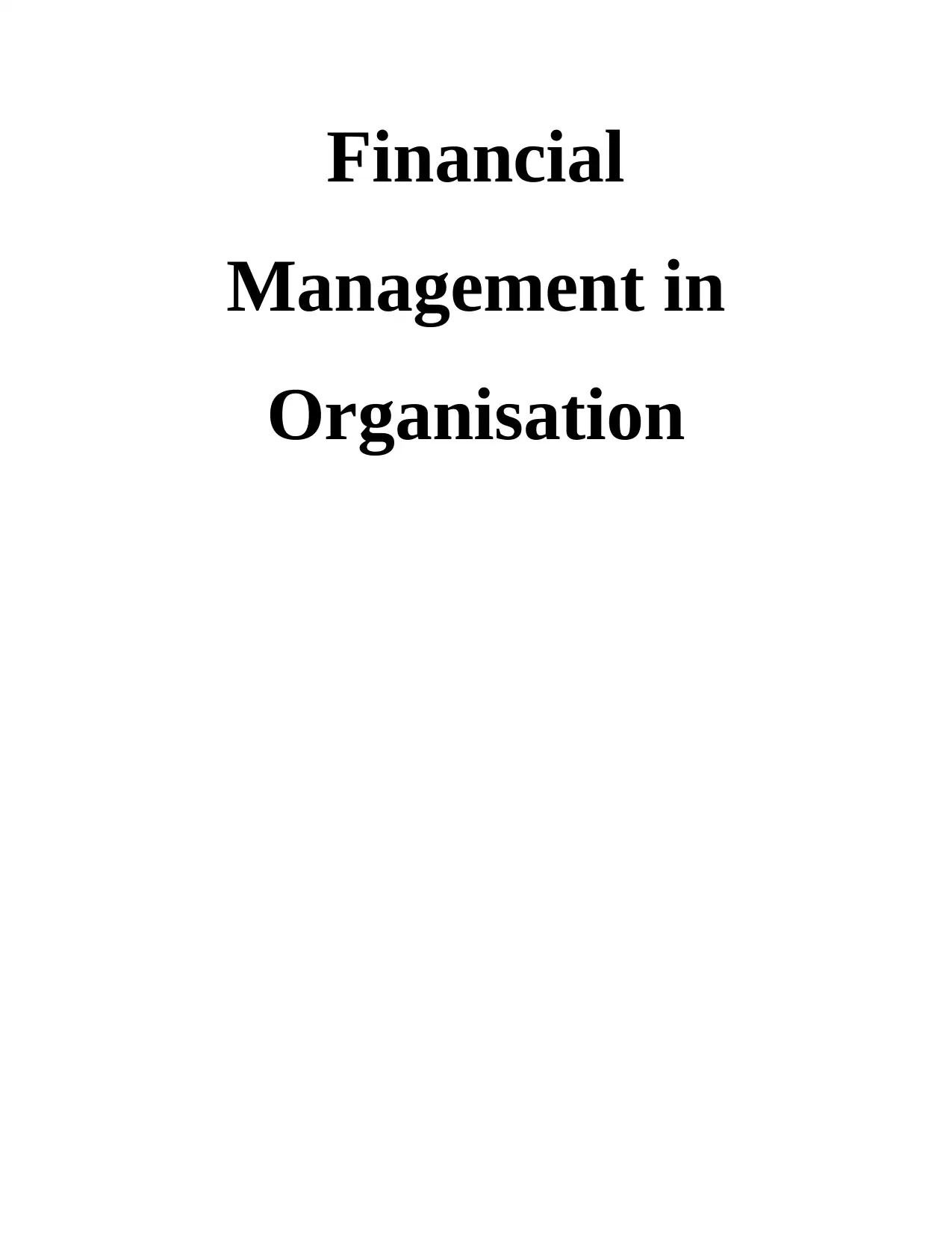
Financial
Management in
Organisation
Management in
Organisation
Paraphrase This Document
Need a fresh take? Get an instant paraphrase of this document with our AI Paraphraser
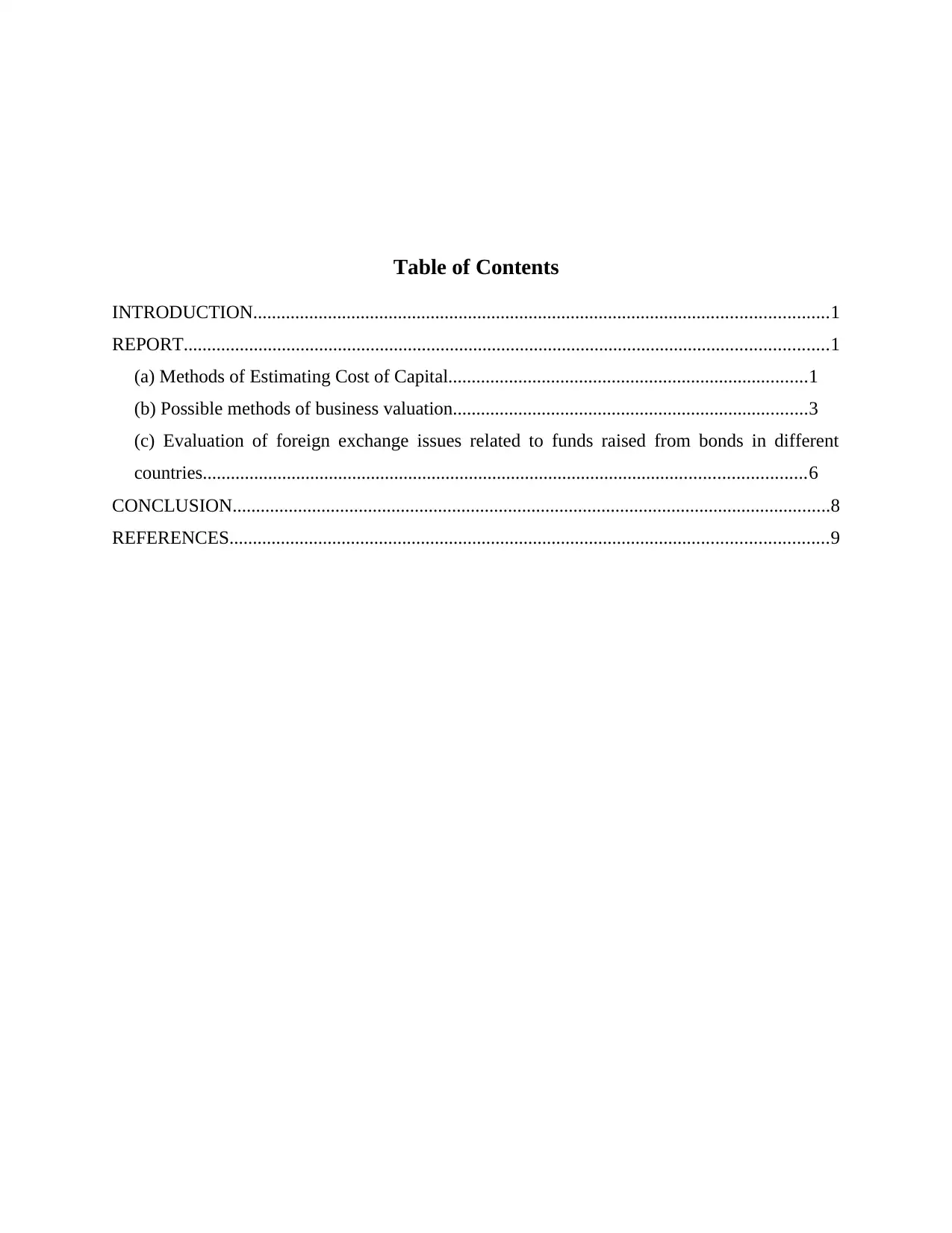
Table of Contents
INTRODUCTION...........................................................................................................................1
REPORT..........................................................................................................................................1
(a) Methods of Estimating Cost of Capital.............................................................................1
(b) Possible methods of business valuation............................................................................3
(c) Evaluation of foreign exchange issues related to funds raised from bonds in different
countries.................................................................................................................................6
CONCLUSION................................................................................................................................8
REFERENCES................................................................................................................................9
INTRODUCTION...........................................................................................................................1
REPORT..........................................................................................................................................1
(a) Methods of Estimating Cost of Capital.............................................................................1
(b) Possible methods of business valuation............................................................................3
(c) Evaluation of foreign exchange issues related to funds raised from bonds in different
countries.................................................................................................................................6
CONCLUSION................................................................................................................................8
REFERENCES................................................................................................................................9
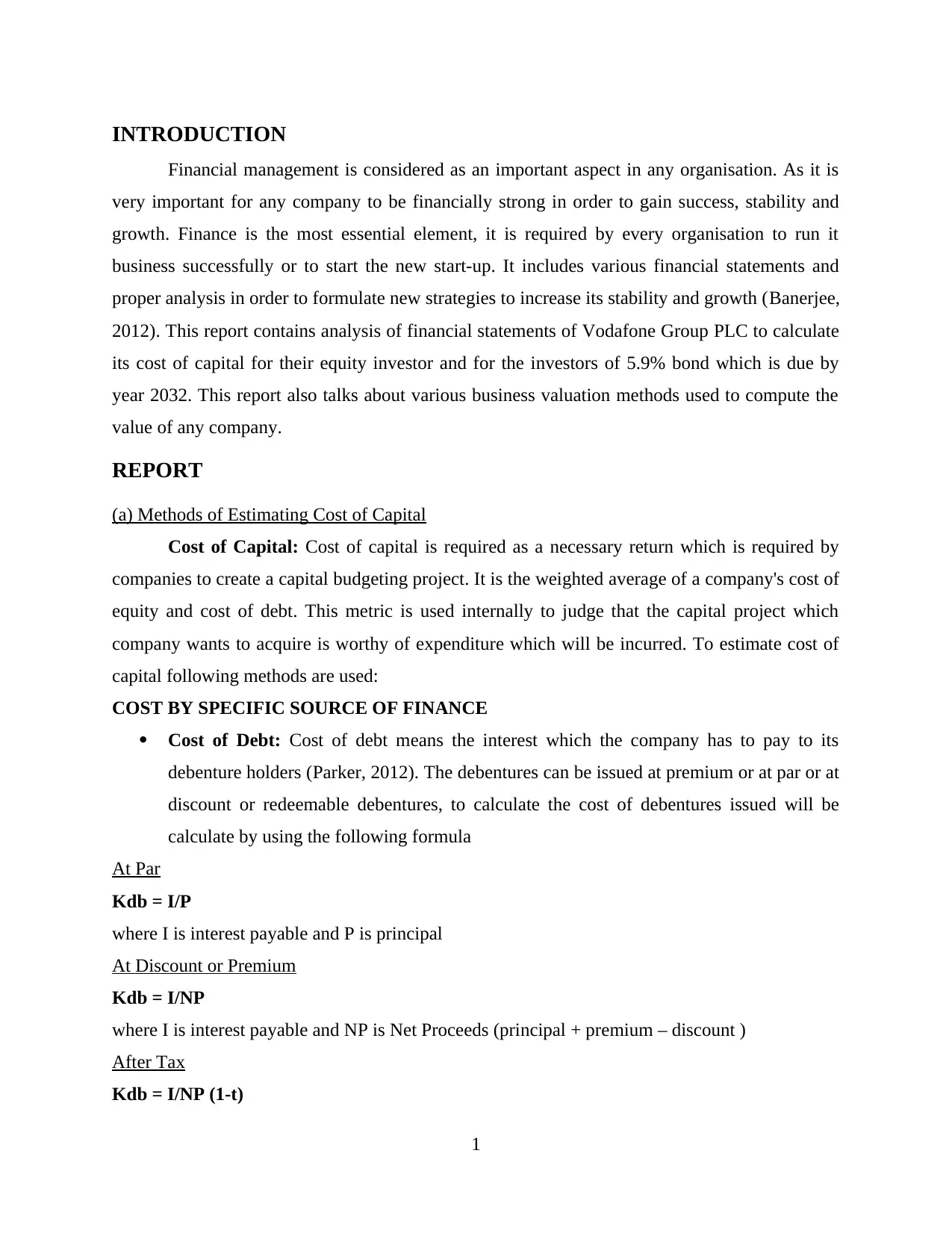
INTRODUCTION
Financial management is considered as an important aspect in any organisation. As it is
very important for any company to be financially strong in order to gain success, stability and
growth. Finance is the most essential element, it is required by every organisation to run it
business successfully or to start the new start-up. It includes various financial statements and
proper analysis in order to formulate new strategies to increase its stability and growth (Banerjee,
2012). This report contains analysis of financial statements of Vodafone Group PLC to calculate
its cost of capital for their equity investor and for the investors of 5.9% bond which is due by
year 2032. This report also talks about various business valuation methods used to compute the
value of any company.
REPORT
(a) Methods of Estimating Cost of Capital
Cost of Capital: Cost of capital is required as a necessary return which is required by
companies to create a capital budgeting project. It is the weighted average of a company's cost of
equity and cost of debt. This metric is used internally to judge that the capital project which
company wants to acquire is worthy of expenditure which will be incurred. To estimate cost of
capital following methods are used:
COST BY SPECIFIC SOURCE OF FINANCE
Cost of Debt: Cost of debt means the interest which the company has to pay to its
debenture holders (Parker, 2012). The debentures can be issued at premium or at par or at
discount or redeemable debentures, to calculate the cost of debentures issued will be
calculate by using the following formula
At Par
Kdb = I/P
where I is interest payable and P is principal
At Discount or Premium
Kdb = I/NP
where I is interest payable and NP is Net Proceeds (principal + premium – discount )
After Tax
Kdb = I/NP (1-t)
1
Financial management is considered as an important aspect in any organisation. As it is
very important for any company to be financially strong in order to gain success, stability and
growth. Finance is the most essential element, it is required by every organisation to run it
business successfully or to start the new start-up. It includes various financial statements and
proper analysis in order to formulate new strategies to increase its stability and growth (Banerjee,
2012). This report contains analysis of financial statements of Vodafone Group PLC to calculate
its cost of capital for their equity investor and for the investors of 5.9% bond which is due by
year 2032. This report also talks about various business valuation methods used to compute the
value of any company.
REPORT
(a) Methods of Estimating Cost of Capital
Cost of Capital: Cost of capital is required as a necessary return which is required by
companies to create a capital budgeting project. It is the weighted average of a company's cost of
equity and cost of debt. This metric is used internally to judge that the capital project which
company wants to acquire is worthy of expenditure which will be incurred. To estimate cost of
capital following methods are used:
COST BY SPECIFIC SOURCE OF FINANCE
Cost of Debt: Cost of debt means the interest which the company has to pay to its
debenture holders (Parker, 2012). The debentures can be issued at premium or at par or at
discount or redeemable debentures, to calculate the cost of debentures issued will be
calculate by using the following formula
At Par
Kdb = I/P
where I is interest payable and P is principal
At Discount or Premium
Kdb = I/NP
where I is interest payable and NP is Net Proceeds (principal + premium – discount )
After Tax
Kdb = I/NP (1-t)
1
⊘ This is a preview!⊘
Do you want full access?
Subscribe today to unlock all pages.

Trusted by 1+ million students worldwide
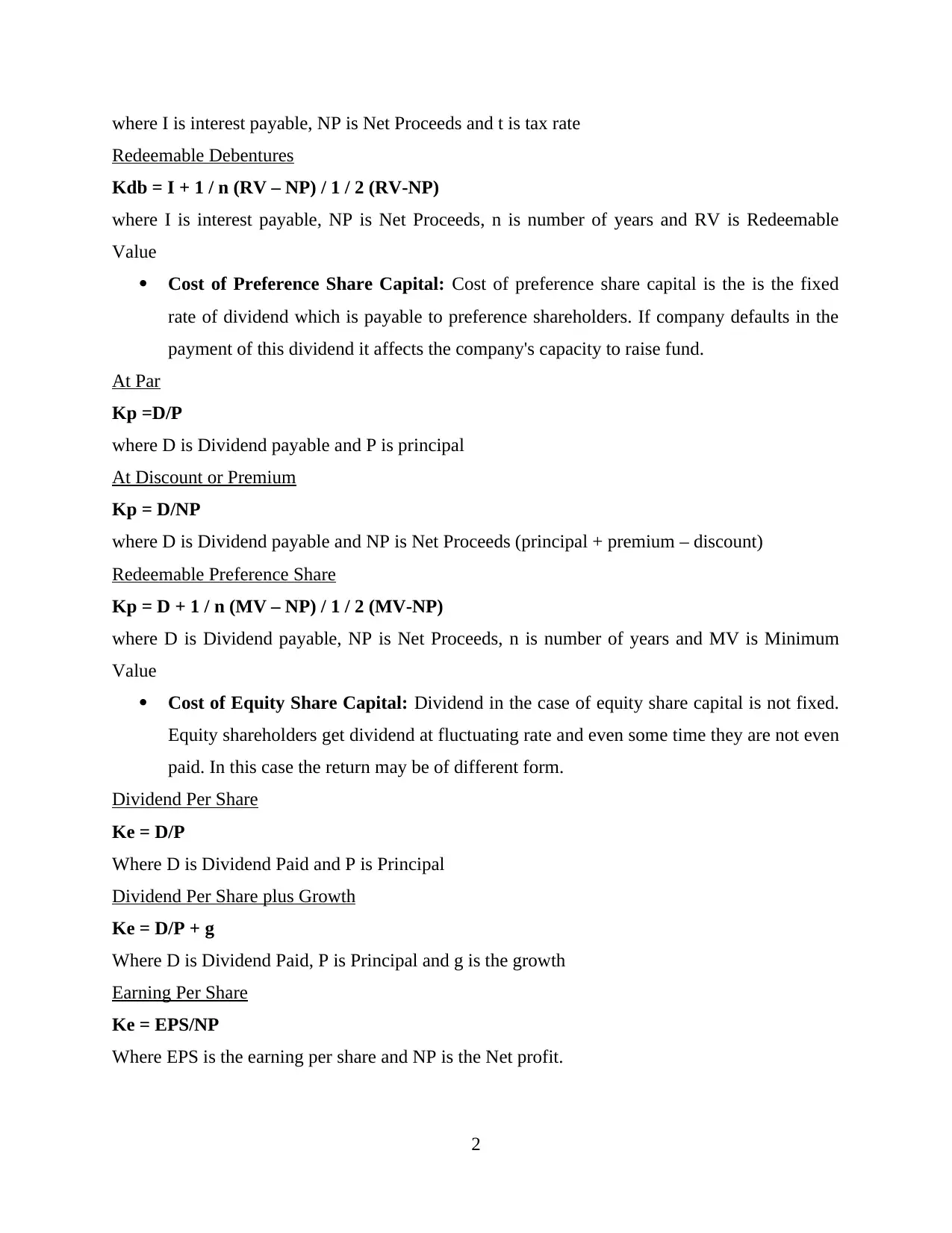
where I is interest payable, NP is Net Proceeds and t is tax rate
Redeemable Debentures
Kdb = I + 1 / n (RV – NP) / 1 / 2 (RV-NP)
where I is interest payable, NP is Net Proceeds, n is number of years and RV is Redeemable
Value
Cost of Preference Share Capital: Cost of preference share capital is the is the fixed
rate of dividend which is payable to preference shareholders. If company defaults in the
payment of this dividend it affects the company's capacity to raise fund.
At Par
Kp =D/P
where D is Dividend payable and P is principal
At Discount or Premium
Kp = D/NP
where D is Dividend payable and NP is Net Proceeds (principal + premium – discount)
Redeemable Preference Share
Kp = D + 1 / n (MV – NP) / 1 / 2 (MV-NP)
where D is Dividend payable, NP is Net Proceeds, n is number of years and MV is Minimum
Value
Cost of Equity Share Capital: Dividend in the case of equity share capital is not fixed.
Equity shareholders get dividend at fluctuating rate and even some time they are not even
paid. In this case the return may be of different form.
Dividend Per Share
Ke = D/P
Where D is Dividend Paid and P is Principal
Dividend Per Share plus Growth
Ke = D/P + g
Where D is Dividend Paid, P is Principal and g is the growth
Earning Per Share
Ke = EPS/NP
Where EPS is the earning per share and NP is the Net profit.
2
Redeemable Debentures
Kdb = I + 1 / n (RV – NP) / 1 / 2 (RV-NP)
where I is interest payable, NP is Net Proceeds, n is number of years and RV is Redeemable
Value
Cost of Preference Share Capital: Cost of preference share capital is the is the fixed
rate of dividend which is payable to preference shareholders. If company defaults in the
payment of this dividend it affects the company's capacity to raise fund.
At Par
Kp =D/P
where D is Dividend payable and P is principal
At Discount or Premium
Kp = D/NP
where D is Dividend payable and NP is Net Proceeds (principal + premium – discount)
Redeemable Preference Share
Kp = D + 1 / n (MV – NP) / 1 / 2 (MV-NP)
where D is Dividend payable, NP is Net Proceeds, n is number of years and MV is Minimum
Value
Cost of Equity Share Capital: Dividend in the case of equity share capital is not fixed.
Equity shareholders get dividend at fluctuating rate and even some time they are not even
paid. In this case the return may be of different form.
Dividend Per Share
Ke = D/P
Where D is Dividend Paid and P is Principal
Dividend Per Share plus Growth
Ke = D/P + g
Where D is Dividend Paid, P is Principal and g is the growth
Earning Per Share
Ke = EPS/NP
Where EPS is the earning per share and NP is the Net profit.
2
Paraphrase This Document
Need a fresh take? Get an instant paraphrase of this document with our AI Paraphraser
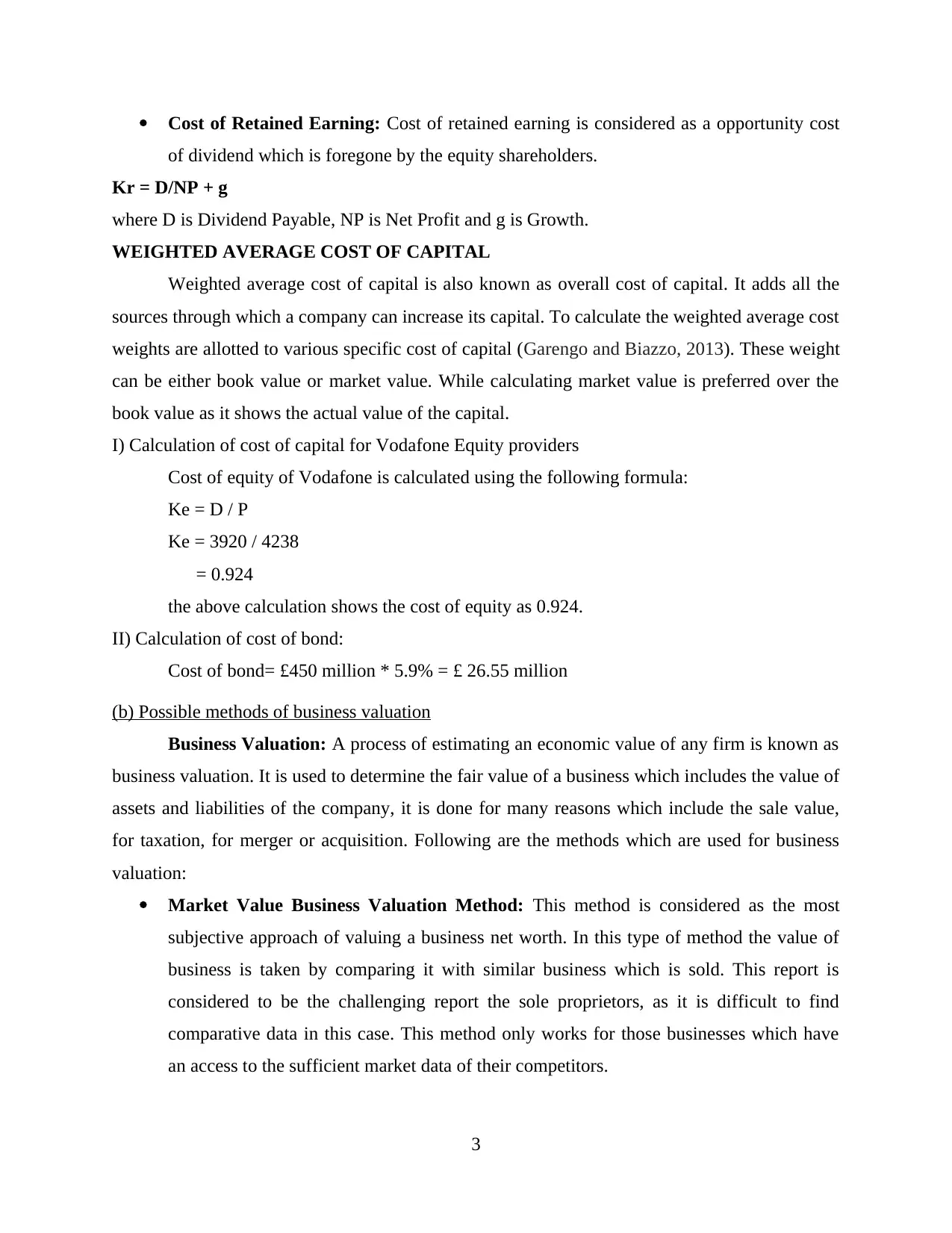
Cost of Retained Earning: Cost of retained earning is considered as a opportunity cost
of dividend which is foregone by the equity shareholders.
Kr = D/NP + g
where D is Dividend Payable, NP is Net Profit and g is Growth.
WEIGHTED AVERAGE COST OF CAPITAL
Weighted average cost of capital is also known as overall cost of capital. It adds all the
sources through which a company can increase its capital. To calculate the weighted average cost
weights are allotted to various specific cost of capital (Garengo and Biazzo, 2013). These weight
can be either book value or market value. While calculating market value is preferred over the
book value as it shows the actual value of the capital.
I) Calculation of cost of capital for Vodafone Equity providers
Cost of equity of Vodafone is calculated using the following formula:
Ke = D / P
Ke = 3920 / 4238
= 0.924
the above calculation shows the cost of equity as 0.924.
II) Calculation of cost of bond:
Cost of bond= £450 million * 5.9% = £ 26.55 million
(b) Possible methods of business valuation
Business Valuation: A process of estimating an economic value of any firm is known as
business valuation. It is used to determine the fair value of a business which includes the value of
assets and liabilities of the company, it is done for many reasons which include the sale value,
for taxation, for merger or acquisition. Following are the methods which are used for business
valuation:
Market Value Business Valuation Method: This method is considered as the most
subjective approach of valuing a business net worth. In this type of method the value of
business is taken by comparing it with similar business which is sold. This report is
considered to be the challenging report the sole proprietors, as it is difficult to find
comparative data in this case. This method only works for those businesses which have
an access to the sufficient market data of their competitors.
3
of dividend which is foregone by the equity shareholders.
Kr = D/NP + g
where D is Dividend Payable, NP is Net Profit and g is Growth.
WEIGHTED AVERAGE COST OF CAPITAL
Weighted average cost of capital is also known as overall cost of capital. It adds all the
sources through which a company can increase its capital. To calculate the weighted average cost
weights are allotted to various specific cost of capital (Garengo and Biazzo, 2013). These weight
can be either book value or market value. While calculating market value is preferred over the
book value as it shows the actual value of the capital.
I) Calculation of cost of capital for Vodafone Equity providers
Cost of equity of Vodafone is calculated using the following formula:
Ke = D / P
Ke = 3920 / 4238
= 0.924
the above calculation shows the cost of equity as 0.924.
II) Calculation of cost of bond:
Cost of bond= £450 million * 5.9% = £ 26.55 million
(b) Possible methods of business valuation
Business Valuation: A process of estimating an economic value of any firm is known as
business valuation. It is used to determine the fair value of a business which includes the value of
assets and liabilities of the company, it is done for many reasons which include the sale value,
for taxation, for merger or acquisition. Following are the methods which are used for business
valuation:
Market Value Business Valuation Method: This method is considered as the most
subjective approach of valuing a business net worth. In this type of method the value of
business is taken by comparing it with similar business which is sold. This report is
considered to be the challenging report the sole proprietors, as it is difficult to find
comparative data in this case. This method only works for those businesses which have
an access to the sufficient market data of their competitors.
3
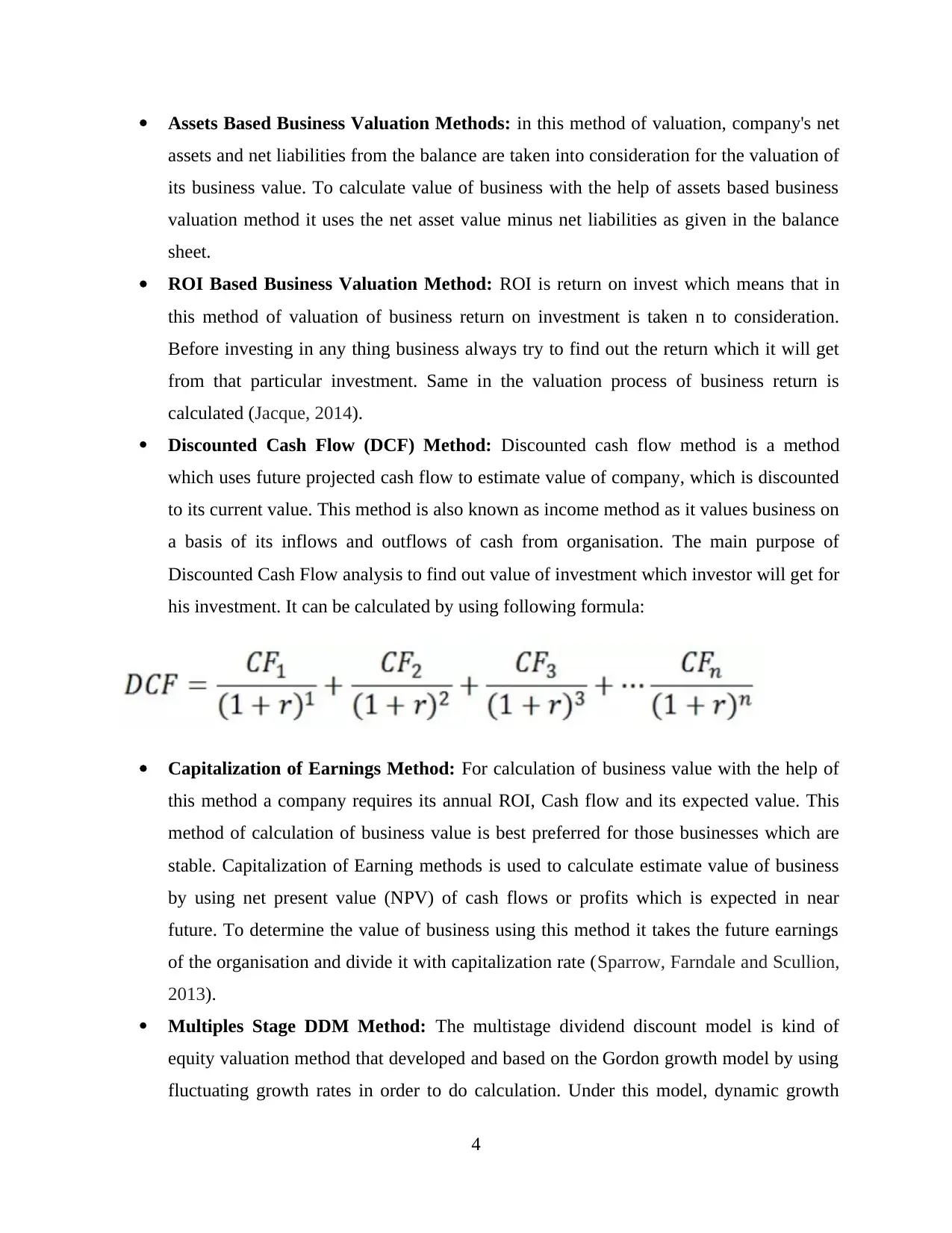
Assets Based Business Valuation Methods: in this method of valuation, company's net
assets and net liabilities from the balance are taken into consideration for the valuation of
its business value. To calculate value of business with the help of assets based business
valuation method it uses the net asset value minus net liabilities as given in the balance
sheet.
ROI Based Business Valuation Method: ROI is return on invest which means that in
this method of valuation of business return on investment is taken n to consideration.
Before investing in any thing business always try to find out the return which it will get
from that particular investment. Same in the valuation process of business return is
calculated (Jacque, 2014).
Discounted Cash Flow (DCF) Method: Discounted cash flow method is a method
which uses future projected cash flow to estimate value of company, which is discounted
to its current value. This method is also known as income method as it values business on
a basis of its inflows and outflows of cash from organisation. The main purpose of
Discounted Cash Flow analysis to find out value of investment which investor will get for
his investment. It can be calculated by using following formula:
Capitalization of Earnings Method: For calculation of business value with the help of
this method a company requires its annual ROI, Cash flow and its expected value. This
method of calculation of business value is best preferred for those businesses which are
stable. Capitalization of Earning methods is used to calculate estimate value of business
by using net present value (NPV) of cash flows or profits which is expected in near
future. To determine the value of business using this method it takes the future earnings
of the organisation and divide it with capitalization rate (Sparrow, Farndale and Scullion,
2013).
Multiples Stage DDM Method: The multistage dividend discount model is kind of
equity valuation method that developed and based on the Gordon growth model by using
fluctuating growth rates in order to do calculation. Under this model, dynamic growth
4
assets and net liabilities from the balance are taken into consideration for the valuation of
its business value. To calculate value of business with the help of assets based business
valuation method it uses the net asset value minus net liabilities as given in the balance
sheet.
ROI Based Business Valuation Method: ROI is return on invest which means that in
this method of valuation of business return on investment is taken n to consideration.
Before investing in any thing business always try to find out the return which it will get
from that particular investment. Same in the valuation process of business return is
calculated (Jacque, 2014).
Discounted Cash Flow (DCF) Method: Discounted cash flow method is a method
which uses future projected cash flow to estimate value of company, which is discounted
to its current value. This method is also known as income method as it values business on
a basis of its inflows and outflows of cash from organisation. The main purpose of
Discounted Cash Flow analysis to find out value of investment which investor will get for
his investment. It can be calculated by using following formula:
Capitalization of Earnings Method: For calculation of business value with the help of
this method a company requires its annual ROI, Cash flow and its expected value. This
method of calculation of business value is best preferred for those businesses which are
stable. Capitalization of Earning methods is used to calculate estimate value of business
by using net present value (NPV) of cash flows or profits which is expected in near
future. To determine the value of business using this method it takes the future earnings
of the organisation and divide it with capitalization rate (Sparrow, Farndale and Scullion,
2013).
Multiples Stage DDM Method: The multistage dividend discount model is kind of
equity valuation method that developed and based on the Gordon growth model by using
fluctuating growth rates in order to do calculation. Under this model, dynamic growth
4
⊘ This is a preview!⊘
Do you want full access?
Subscribe today to unlock all pages.

Trusted by 1+ million students worldwide
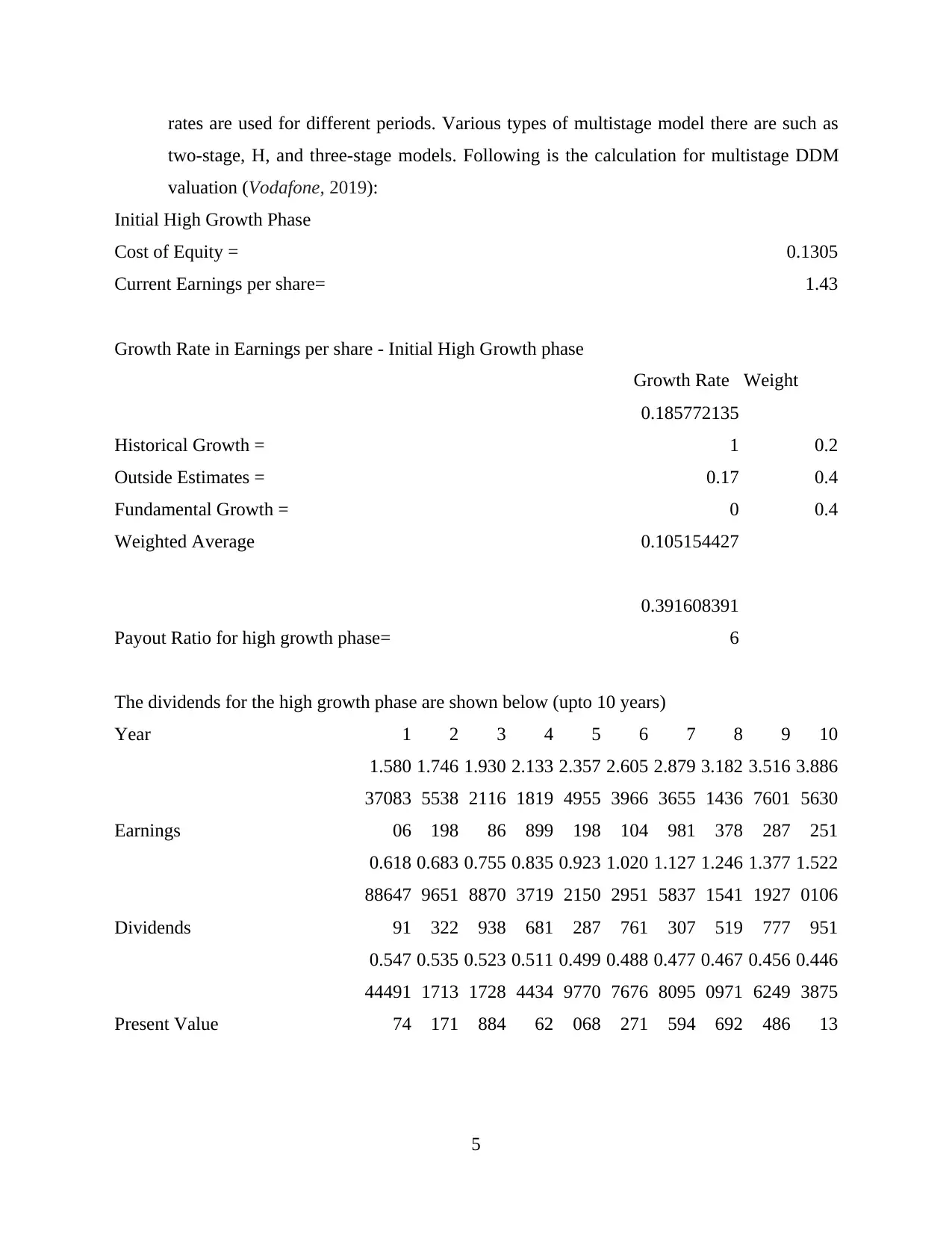
rates are used for different periods. Various types of multistage model there are such as
two-stage, H, and three-stage models. Following is the calculation for multistage DDM
valuation (Vodafone, 2019):
Initial High Growth Phase
Cost of Equity = 0.1305
Current Earnings per share= 1.43
Growth Rate in Earnings per share - Initial High Growth phase
Growth Rate Weight
Historical Growth =
0.185772135
1 0.2
Outside Estimates = 0.17 0.4
Fundamental Growth = 0 0.4
Weighted Average 0.105154427
Payout Ratio for high growth phase=
0.391608391
6
The dividends for the high growth phase are shown below (upto 10 years)
Year 1 2 3 4 5 6 7 8 9 10
Earnings
1.580
37083
06
1.746
5538
198
1.930
2116
86
2.133
1819
899
2.357
4955
198
2.605
3966
104
2.879
3655
981
3.182
1436
378
3.516
7601
287
3.886
5630
251
Dividends
0.618
88647
91
0.683
9651
322
0.755
8870
938
0.835
3719
681
0.923
2150
287
1.020
2951
761
1.127
5837
307
1.246
1541
519
1.377
1927
777
1.522
0106
951
Present Value
0.547
44491
74
0.535
1713
171
0.523
1728
884
0.511
4434
62
0.499
9770
068
0.488
7676
271
0.477
8095
594
0.467
0971
692
0.456
6249
486
0.446
3875
13
5
two-stage, H, and three-stage models. Following is the calculation for multistage DDM
valuation (Vodafone, 2019):
Initial High Growth Phase
Cost of Equity = 0.1305
Current Earnings per share= 1.43
Growth Rate in Earnings per share - Initial High Growth phase
Growth Rate Weight
Historical Growth =
0.185772135
1 0.2
Outside Estimates = 0.17 0.4
Fundamental Growth = 0 0.4
Weighted Average 0.105154427
Payout Ratio for high growth phase=
0.391608391
6
The dividends for the high growth phase are shown below (upto 10 years)
Year 1 2 3 4 5 6 7 8 9 10
Earnings
1.580
37083
06
1.746
5538
198
1.930
2116
86
2.133
1819
899
2.357
4955
198
2.605
3966
104
2.879
3655
981
3.182
1436
378
3.516
7601
287
3.886
5630
251
Dividends
0.618
88647
91
0.683
9651
322
0.755
8870
938
0.835
3719
681
0.923
2150
287
1.020
2951
761
1.127
5837
307
1.246
1541
519
1.377
1927
777
1.522
0106
951
Present Value
0.547
44491
74
0.535
1713
171
0.523
1728
884
0.511
4434
62
0.499
9770
068
0.488
7676
271
0.477
8095
594
0.467
0971
692
0.456
6249
486
0.446
3875
13
5
Paraphrase This Document
Need a fresh take? Get an instant paraphrase of this document with our AI Paraphraser
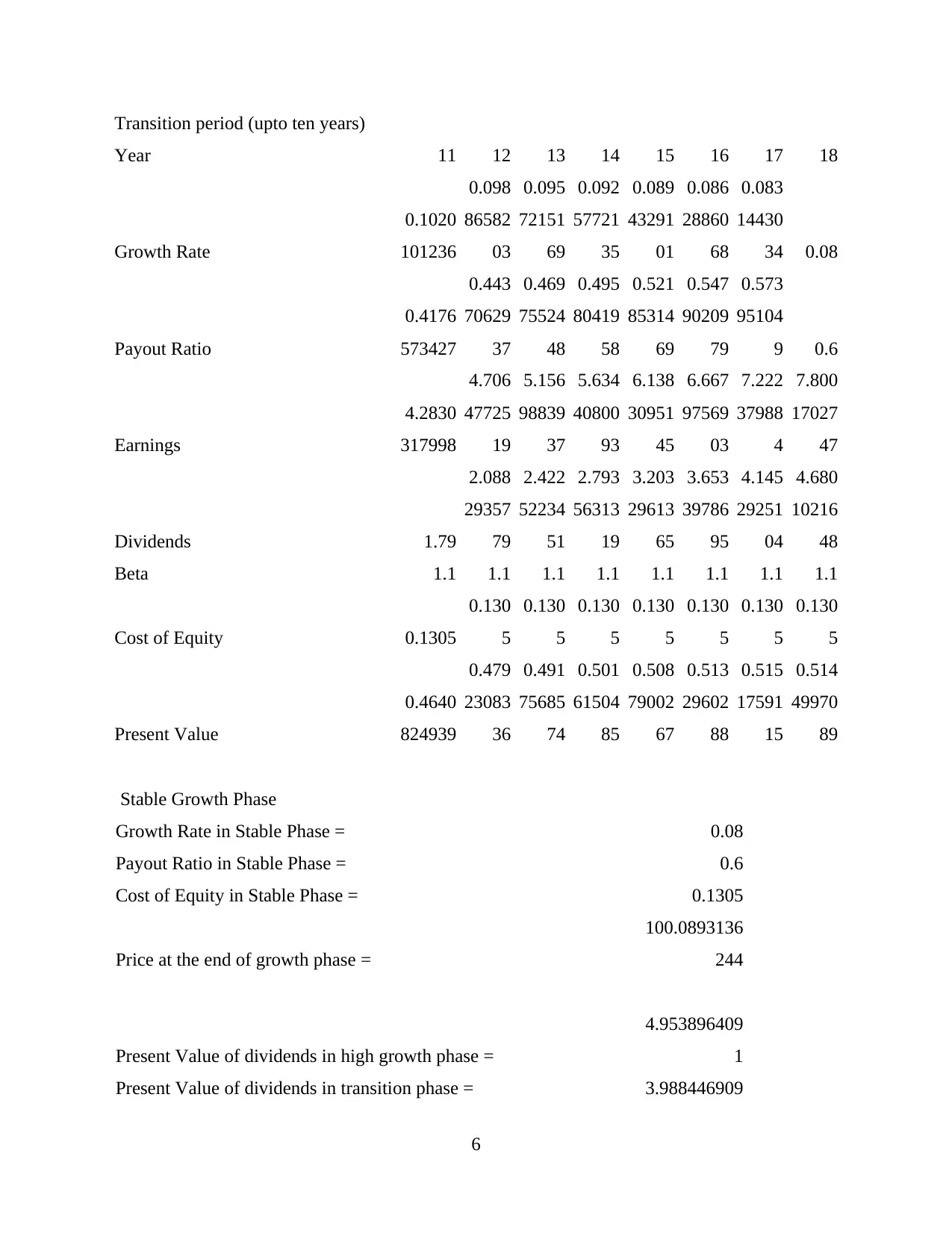
Transition period (upto ten years)
Year 11 12 13 14 15 16 17 18
Growth Rate
0.1020
101236
0.098
86582
03
0.095
72151
69
0.092
57721
35
0.089
43291
01
0.086
28860
68
0.083
14430
34 0.08
Payout Ratio
0.4176
573427
0.443
70629
37
0.469
75524
48
0.495
80419
58
0.521
85314
69
0.547
90209
79
0.573
95104
9 0.6
Earnings
4.2830
317998
4.706
47725
19
5.156
98839
37
5.634
40800
93
6.138
30951
45
6.667
97569
03
7.222
37988
4
7.800
17027
47
Dividends 1.79
2.088
29357
79
2.422
52234
51
2.793
56313
19
3.203
29613
65
3.653
39786
95
4.145
29251
04
4.680
10216
48
Beta 1.1 1.1 1.1 1.1 1.1 1.1 1.1 1.1
Cost of Equity 0.1305
0.130
5
0.130
5
0.130
5
0.130
5
0.130
5
0.130
5
0.130
5
Present Value
0.4640
824939
0.479
23083
36
0.491
75685
74
0.501
61504
85
0.508
79002
67
0.513
29602
88
0.515
17591
15
0.514
49970
89
Stable Growth Phase
Growth Rate in Stable Phase = 0.08
Payout Ratio in Stable Phase = 0.6
Cost of Equity in Stable Phase = 0.1305
Price at the end of growth phase =
100.0893136
244
Present Value of dividends in high growth phase =
4.953896409
1
Present Value of dividends in transition phase = 3.988446909
6
Year 11 12 13 14 15 16 17 18
Growth Rate
0.1020
101236
0.098
86582
03
0.095
72151
69
0.092
57721
35
0.089
43291
01
0.086
28860
68
0.083
14430
34 0.08
Payout Ratio
0.4176
573427
0.443
70629
37
0.469
75524
48
0.495
80419
58
0.521
85314
69
0.547
90209
79
0.573
95104
9 0.6
Earnings
4.2830
317998
4.706
47725
19
5.156
98839
37
5.634
40800
93
6.138
30951
45
6.667
97569
03
7.222
37988
4
7.800
17027
47
Dividends 1.79
2.088
29357
79
2.422
52234
51
2.793
56313
19
3.203
29613
65
3.653
39786
95
4.145
29251
04
4.680
10216
48
Beta 1.1 1.1 1.1 1.1 1.1 1.1 1.1 1.1
Cost of Equity 0.1305
0.130
5
0.130
5
0.130
5
0.130
5
0.130
5
0.130
5
0.130
5
Present Value
0.4640
824939
0.479
23083
36
0.491
75685
74
0.501
61504
85
0.508
79002
67
0.513
29602
88
0.515
17591
15
0.514
49970
89
Stable Growth Phase
Growth Rate in Stable Phase = 0.08
Payout Ratio in Stable Phase = 0.6
Cost of Equity in Stable Phase = 0.1305
Price at the end of growth phase =
100.0893136
244
Present Value of dividends in high growth phase =
4.953896409
1
Present Value of dividends in transition phase = 3.988446909
6
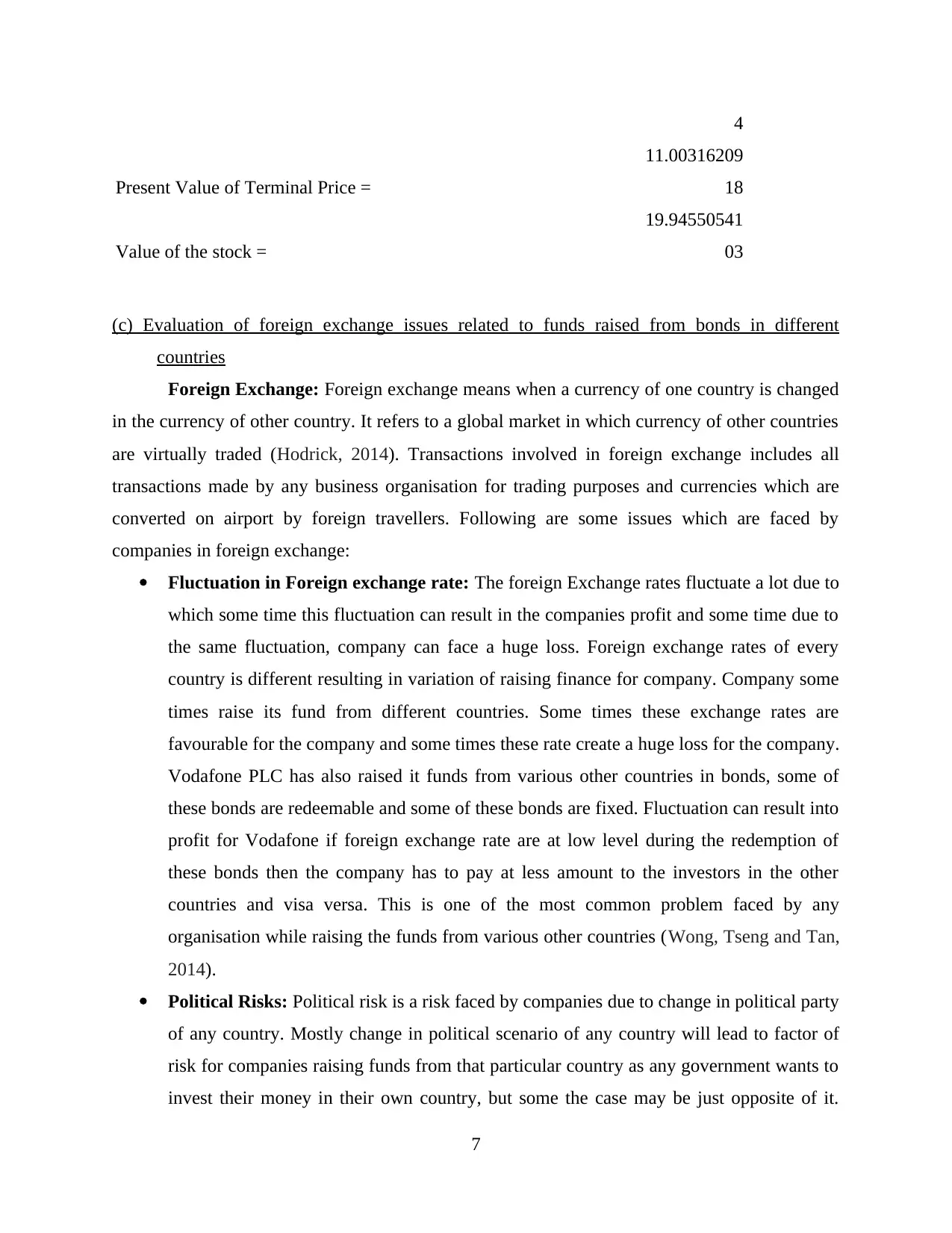
4
Present Value of Terminal Price =
11.00316209
18
Value of the stock =
19.94550541
03
(c) Evaluation of foreign exchange issues related to funds raised from bonds in different
countries
Foreign Exchange: Foreign exchange means when a currency of one country is changed
in the currency of other country. It refers to a global market in which currency of other countries
are virtually traded (Hodrick, 2014). Transactions involved in foreign exchange includes all
transactions made by any business organisation for trading purposes and currencies which are
converted on airport by foreign travellers. Following are some issues which are faced by
companies in foreign exchange:
Fluctuation in Foreign exchange rate: The foreign Exchange rates fluctuate a lot due to
which some time this fluctuation can result in the companies profit and some time due to
the same fluctuation, company can face a huge loss. Foreign exchange rates of every
country is different resulting in variation of raising finance for company. Company some
times raise its fund from different countries. Some times these exchange rates are
favourable for the company and some times these rate create a huge loss for the company.
Vodafone PLC has also raised it funds from various other countries in bonds, some of
these bonds are redeemable and some of these bonds are fixed. Fluctuation can result into
profit for Vodafone if foreign exchange rate are at low level during the redemption of
these bonds then the company has to pay at less amount to the investors in the other
countries and visa versa. This is one of the most common problem faced by any
organisation while raising the funds from various other countries (Wong, Tseng and Tan,
2014).
Political Risks: Political risk is a risk faced by companies due to change in political party
of any country. Mostly change in political scenario of any country will lead to factor of
risk for companies raising funds from that particular country as any government wants to
invest their money in their own country, but some the case may be just opposite of it.
7
Present Value of Terminal Price =
11.00316209
18
Value of the stock =
19.94550541
03
(c) Evaluation of foreign exchange issues related to funds raised from bonds in different
countries
Foreign Exchange: Foreign exchange means when a currency of one country is changed
in the currency of other country. It refers to a global market in which currency of other countries
are virtually traded (Hodrick, 2014). Transactions involved in foreign exchange includes all
transactions made by any business organisation for trading purposes and currencies which are
converted on airport by foreign travellers. Following are some issues which are faced by
companies in foreign exchange:
Fluctuation in Foreign exchange rate: The foreign Exchange rates fluctuate a lot due to
which some time this fluctuation can result in the companies profit and some time due to
the same fluctuation, company can face a huge loss. Foreign exchange rates of every
country is different resulting in variation of raising finance for company. Company some
times raise its fund from different countries. Some times these exchange rates are
favourable for the company and some times these rate create a huge loss for the company.
Vodafone PLC has also raised it funds from various other countries in bonds, some of
these bonds are redeemable and some of these bonds are fixed. Fluctuation can result into
profit for Vodafone if foreign exchange rate are at low level during the redemption of
these bonds then the company has to pay at less amount to the investors in the other
countries and visa versa. This is one of the most common problem faced by any
organisation while raising the funds from various other countries (Wong, Tseng and Tan,
2014).
Political Risks: Political risk is a risk faced by companies due to change in political party
of any country. Mostly change in political scenario of any country will lead to factor of
risk for companies raising funds from that particular country as any government wants to
invest their money in their own country, but some the case may be just opposite of it.
7
⊘ This is a preview!⊘
Do you want full access?
Subscribe today to unlock all pages.

Trusted by 1+ million students worldwide

Political changes create a risk for company that whether the political party in power will
support it or create some strict rules. As for the case of Vodafone PLC changes in the
political party of some countries has lead to risk for investors in other countries creating a
problem for company (Ülkü and Demirci, 2012).
Credit Risk: Credit risk is a risk which is involved in the companies while trading
internationally with other countries. This is a type of risk faced by companies when other
party in some other country fails to execute its parts of obligation to complete that
contract. This risk involves fluctuation of exchange rates due to which party facing loss
does not plays his part in obligation of contract. Investor who have invested in company
and some amount of bond or equity is left to be called upon and foreign exchange rate
increases then those investors does not pay remaining amount.
Interest Rate Risk: Interest rate risk is a risk where interest rate for an investment
changes due to change in rate of foreign exchange. This type of risk is usually involved in
those countries whose currency is not so strong as compared to other countries. Countries
where the foreign exchange rate change frequently every time, some time changes in
exchange rate can benefit the company. Due to the change in the rate of exchange of
foreign currency the interest payable to investors increase when converted in to the
currencies of those countries whose currencies is weak as compared to other countries. In
a case of Vodafone PLC it has raised it capital in form of debts at 5.9% of interest of total
of 450 million. Company has various other debts including the above debts (Kim, 2013).
CONCLUSION
From the above report it can be concluded that financial accounting is an important part
for every organisation. As talked above in the report benefits of financial accounting it helps the
organisation to control its cost. The above report also states methods of calculation of value of
the firm. In this report the value of Vodafone PLC is established and all the issues related to
raising funds from other countries are highlighted.
8
support it or create some strict rules. As for the case of Vodafone PLC changes in the
political party of some countries has lead to risk for investors in other countries creating a
problem for company (Ülkü and Demirci, 2012).
Credit Risk: Credit risk is a risk which is involved in the companies while trading
internationally with other countries. This is a type of risk faced by companies when other
party in some other country fails to execute its parts of obligation to complete that
contract. This risk involves fluctuation of exchange rates due to which party facing loss
does not plays his part in obligation of contract. Investor who have invested in company
and some amount of bond or equity is left to be called upon and foreign exchange rate
increases then those investors does not pay remaining amount.
Interest Rate Risk: Interest rate risk is a risk where interest rate for an investment
changes due to change in rate of foreign exchange. This type of risk is usually involved in
those countries whose currency is not so strong as compared to other countries. Countries
where the foreign exchange rate change frequently every time, some time changes in
exchange rate can benefit the company. Due to the change in the rate of exchange of
foreign currency the interest payable to investors increase when converted in to the
currencies of those countries whose currencies is weak as compared to other countries. In
a case of Vodafone PLC it has raised it capital in form of debts at 5.9% of interest of total
of 450 million. Company has various other debts including the above debts (Kim, 2013).
CONCLUSION
From the above report it can be concluded that financial accounting is an important part
for every organisation. As talked above in the report benefits of financial accounting it helps the
organisation to control its cost. The above report also states methods of calculation of value of
the firm. In this report the value of Vodafone PLC is established and all the issues related to
raising funds from other countries are highlighted.
8
Paraphrase This Document
Need a fresh take? Get an instant paraphrase of this document with our AI Paraphraser
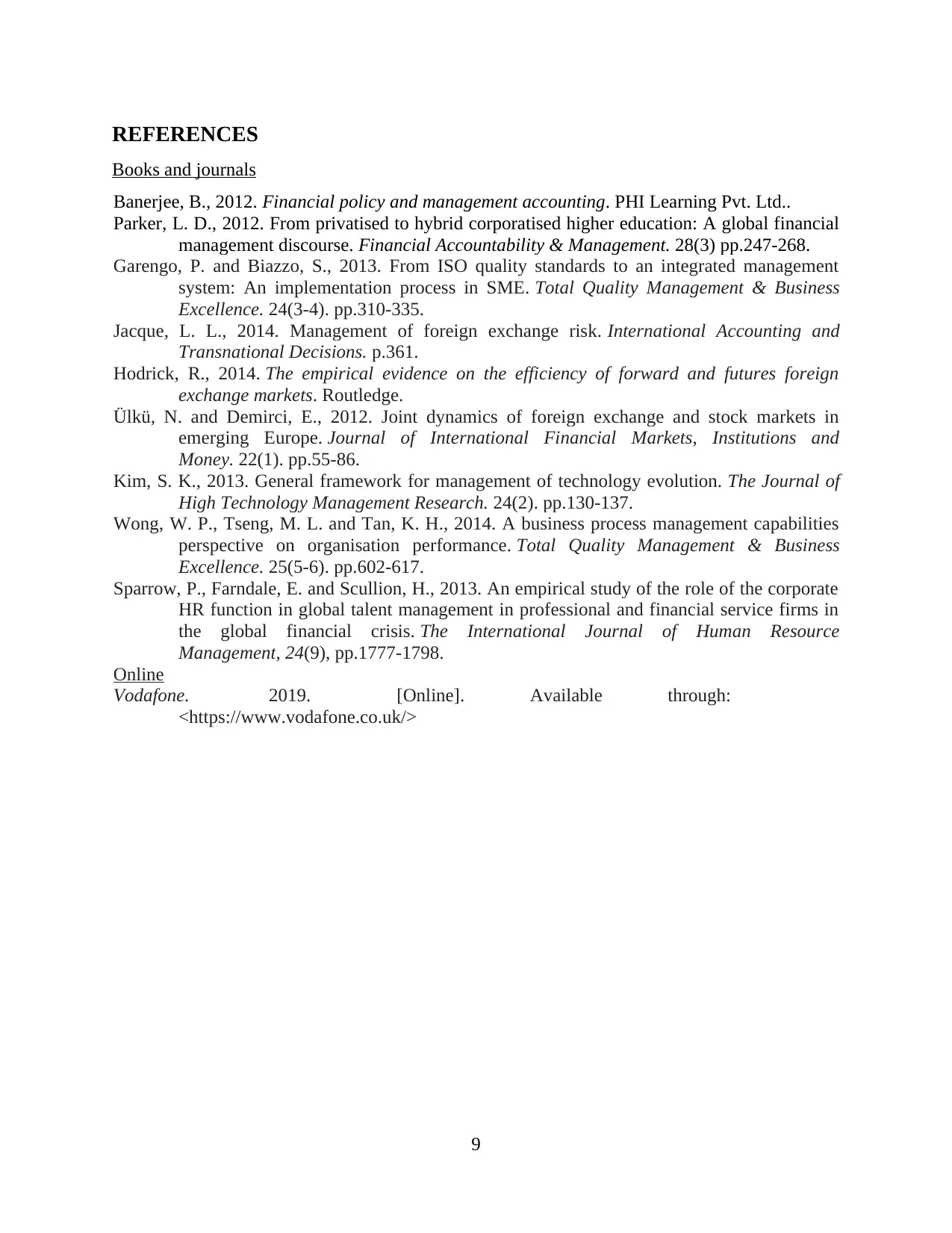
REFERENCES
Books and journals
Banerjee, B., 2012. Financial policy and management accounting. PHI Learning Pvt. Ltd..
Parker, L. D., 2012. From privatised to hybrid corporatised higher education: A global financial
management discourse. Financial Accountability & Management. 28(3) pp.247-268.
Garengo, P. and Biazzo, S., 2013. From ISO quality standards to an integrated management
system: An implementation process in SME. Total Quality Management & Business
Excellence. 24(3-4). pp.310-335.
Jacque, L. L., 2014. Management of foreign exchange risk. International Accounting and
Transnational Decisions. p.361.
Hodrick, R., 2014. The empirical evidence on the efficiency of forward and futures foreign
exchange markets. Routledge.
Ülkü, N. and Demirci, E., 2012. Joint dynamics of foreign exchange and stock markets in
emerging Europe. Journal of International Financial Markets, Institutions and
Money. 22(1). pp.55-86.
Kim, S. K., 2013. General framework for management of technology evolution. The Journal of
High Technology Management Research. 24(2). pp.130-137.
Wong, W. P., Tseng, M. L. and Tan, K. H., 2014. A business process management capabilities
perspective on organisation performance. Total Quality Management & Business
Excellence. 25(5-6). pp.602-617.
Sparrow, P., Farndale, E. and Scullion, H., 2013. An empirical study of the role of the corporate
HR function in global talent management in professional and financial service firms in
the global financial crisis. The International Journal of Human Resource
Management, 24(9), pp.1777-1798.
Online
Vodafone. 2019. [Online]. Available through:
<https://www.vodafone.co.uk/>
9
Books and journals
Banerjee, B., 2012. Financial policy and management accounting. PHI Learning Pvt. Ltd..
Parker, L. D., 2012. From privatised to hybrid corporatised higher education: A global financial
management discourse. Financial Accountability & Management. 28(3) pp.247-268.
Garengo, P. and Biazzo, S., 2013. From ISO quality standards to an integrated management
system: An implementation process in SME. Total Quality Management & Business
Excellence. 24(3-4). pp.310-335.
Jacque, L. L., 2014. Management of foreign exchange risk. International Accounting and
Transnational Decisions. p.361.
Hodrick, R., 2014. The empirical evidence on the efficiency of forward and futures foreign
exchange markets. Routledge.
Ülkü, N. and Demirci, E., 2012. Joint dynamics of foreign exchange and stock markets in
emerging Europe. Journal of International Financial Markets, Institutions and
Money. 22(1). pp.55-86.
Kim, S. K., 2013. General framework for management of technology evolution. The Journal of
High Technology Management Research. 24(2). pp.130-137.
Wong, W. P., Tseng, M. L. and Tan, K. H., 2014. A business process management capabilities
perspective on organisation performance. Total Quality Management & Business
Excellence. 25(5-6). pp.602-617.
Sparrow, P., Farndale, E. and Scullion, H., 2013. An empirical study of the role of the corporate
HR function in global talent management in professional and financial service firms in
the global financial crisis. The International Journal of Human Resource
Management, 24(9), pp.1777-1798.
Online
Vodafone. 2019. [Online]. Available through:
<https://www.vodafone.co.uk/>
9
1 out of 11
Related Documents
Your All-in-One AI-Powered Toolkit for Academic Success.
+13062052269
info@desklib.com
Available 24*7 on WhatsApp / Email
![[object Object]](/_next/static/media/star-bottom.7253800d.svg)
Unlock your academic potential
Copyright © 2020–2025 A2Z Services. All Rights Reserved. Developed and managed by ZUCOL.





